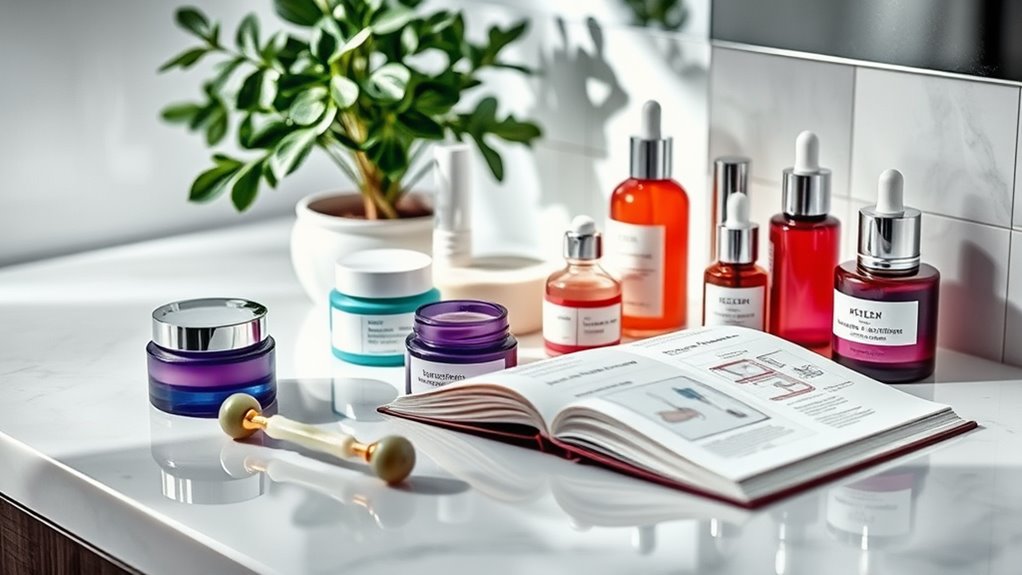Think You Know Your Skincare Order. Think Again
You might think you know how to layer your skincare, but the wrong sequence can sabotage your efforts. Start with cleansers and toners to prep your skin, then apply serums for targeted treatment, followed by moisturizers to lock in hydration. Sunscreen is the essential final step to shield your skin from UV damage. Missteps in your routine can create barriers and dilute effectiveness. Stick around to uncover more about optimizing your skincare game.
The Importance of Skincare Order
Why does the order of your skincare routine matter so much?
When you apply products in the wrong sequence, you risk routine order mistakes that can hinder their effectiveness.
For instance, layering a thick moisturizer before a lightweight serum can create a barrier, preventing absorption.
Start with cleansers and toners to prep your skin, followed by serums that target specific issues.
Finally, lock in hydration with moisturizers and sunscreens.
Each step plays a vital role, and proper application maximizes benefits.
Paying attention to the order guarantees your skin receives the nourishment it needs, leading to healthier, more radiant results. Additionally, skincare layering techniques ensure that each product can penetrate the skin effectively, enhancing overall results.
Common Misconceptions About Product Layering
When it comes to product layering, many people believe that thicker products are always more effective. However, the order in which you apply your skincare is essential for maximizing absorption and benefits. Understanding how to layer your products correctly can transform your routine and enhance your skin’s overall health. Additionally, knowing the importance of skincare truths can help you avoid common pitfalls and achieve better results.
Layering Order Matters
Many people believe that the order in which you apply skincare products is merely a suggestion, but this misconception can lead to suboptimal results.
Proper layering enhances product absorption and effectiveness, ensuring your skin reaps the full benefits.
Here’s what you need to keep in mind:
- Apply products from thinnest to thickest for best penetration.
- Water-based products should come before oil-based ones.
- Active ingredients need time to work; don’t rush the application.
- Layering incorrectly can dilute the efficacy of potent ingredients.
Understanding the right order can transform your skincare routine, making it more effective and tailored for your unique skin needs.
Thickness vs. Effectiveness
How can thickness influence the effectiveness of your skincare products?
Many believe that thicker products automatically provide better results, but that’s a misconception.
The key lies in formulation, not just texture.
Lightweight serums deliver potent ingredients deep into the skin, while heavy creams often act as barriers, sealing moisture in.
Layering correctly is essential; start with thin, water-based products to prep your skin, then move to thicker creams.
Remember, it’s not about slathering on more product, but understanding how each layer interacts.
Focus on ingredients, and trust that the right application order maximizes the benefits for your skin.
The Right Sequence: From Thinnest to Thickest
Understanding the right sequence for applying skincare products is essential for maximizing their effectiveness.
You should always layer your products from thinnest to thickest to achieve proper absorption.
Start with lightweight serums and finish with heavier creams or oils.
Here’s a quick guide:
- Toners: Hydrate and prep your skin.
- Serums: Target specific skin concerns with potent ingredients.
- Moisturizers: Lock in hydration and provide a protective barrier.
- Oils: Seal everything in, adding nourishment and softness.
Following this order helps each product work effectively, allowing your skin to reap the full benefits of your skincare routine. Additionally, incorporating essential serum application tips can further enhance the results you achieve with your products.
Exfoliants: When and How to Use Them
Exfoliants are essential for maintaining smooth, radiant skin, but knowing when and how to use them is key.
You can choose between physical exfoliants, which scrub away dead skin, and chemical exfoliants, which dissolve them at a molecular level.
Depending on your skin type, you might use exfoliants anywhere from once a week to several times a week, so it’s vital to find the right balance. Understanding your skin type can help you choose the most effective exfoliation method for your needs.
Types of Exfoliants
Achieving radiant skin often starts with effective exfoliation, an essential step in any skincare routine.
Knowing the types of exfoliants available can help you choose the right one for your skin type and needs:
- Physical Exfoliants: Scrubs or brushes that manually remove dead skin cells.
- Chemical Exfoliants: Products containing acids (like AHAs and BHAs) that dissolve dead skin.
- Enzymatic Exfoliants: Natural enzymes from fruits that gently break down dead skin.
- Microdermabrasion: Professional treatment using fine crystals to polish the skin’s surface.
Incorporating the right exfoliant can reveal smoother, healthier skin, making it an essential part of your routine.
Frequency of Use
Regular exfoliation is key to maintaining healthy skin, but finding the right frequency can be a bit tricky. Generally, you should exfoliate 1-3 times a week, depending on your skin type and the exfoliant used. For sensitive skin, opt for gentler exfoliants and limit use to once a week. Oily or acne-prone skin can handle more frequent treatments. Here’s a quick reference:
| Skin Type | Frequency |
|---|---|
| Sensitive | 1 time/week |
| Normal/Combination | 2-3 times/week |
| Oily/Acne-prone | 2-3 times/week |
Adjust based on your skin’s response!
Serums vs. Oils: Understanding Their Place
How do you choose between serums and oils in your skincare routine?
Both have unique benefits and play distinct roles.
Serums are typically water-based and packed with active ingredients, targeting specific skin concerns like wrinkles or hyperpigmentation.
Oils, on the other hand, provide hydration and lock in moisture, often containing nourishing fatty acids.
Consider these points:
- Texture: Serums absorb quickly; oils provide a heavier feel.
- Purpose: Use serums for targeted treatment; oils for hydration.
- Skin Type: Oily skin might prefer serums, while dry skin benefits from oils.
- Layering: Apply serum before oil for best results.
Additionally, it’s crucial to choose a serum that is suited to your skin type and concerns, as serums contain active ingredients that specifically address those issues.
The Role of Moisturizer in Your Routine
What role does a moisturizer play in your skincare routine?
A moisturizer hydrates and locks in moisture, ensuring your skin remains plump and healthy. It acts as a barrier, preventing water loss while delivering essential nutrients. You should choose a formula suited to your skin type—lightweight gels for oily skin or rich creams for dry skin. Applying moisturizer after serums allows its ingredients to penetrate effectively, enhancing overall results. Regular use can improve skin texture, reduce fine lines, and provide a smooth canvas for makeup. Skipping moisturizer, even for a short period, can lead to increased skin dryness and negatively affect your skin’s health.
Sunscreen: The Final Step You Can’t Skip
Although you may be tempted to skip it, sunscreen is an essential step in your skincare routine that you simply can’t overlook.
It protects your skin from harmful UV rays, preventing premature aging and skin cancer.
Applying sunscreen daily, even on cloudy days, is vital for maintaining healthy skin.
- Shields against UV damage
- Prevents dark spots and hyperpigmentation
- Preserves skin elasticity and youthfulness
- Enhances the effectiveness of other skincare products
Make sure to apply it as the final step of your routine, allowing it to form a protective barrier that keeps your skin safe. Proper application techniques are crucial for maximizing its effectiveness.
Don’t underestimate its importance!
Adjusting Your Routine for Seasonal Changes
As the seasons change, have you considered how your skincare routine should adapt?
In colder months, switch to a richer moisturizer to combat dryness and protect your skin’s barrier. Look for ingredients like hyaluronic acid and ceramides.
During warmer months, lightweight gels or lotions are ideal, as they hydrate without feeling heavy.
Don’t forget to adjust your exfoliation frequency; skin may be more sensitive in winter but benefit from regular exfoliation in summer.
Always re-evaluate your sunscreen as UV exposure intensifies.

